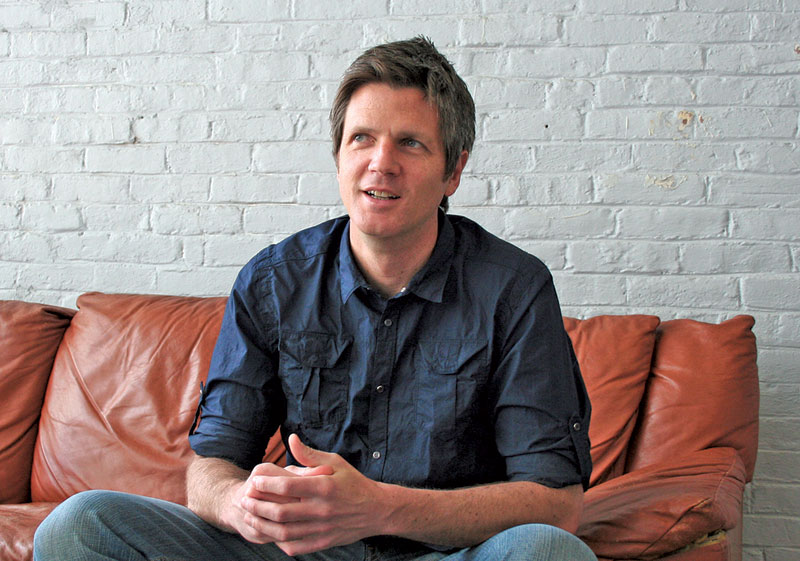Pull Up A Stool with Chris Lohring
of Notch Brewing Co.
Chris Lohring began his brewing career at Kennebunkport Brewing and then co-founded Tremont Brewing in Boston in 1993. He now brews Notch beers, which are all session strength, at three New England breweries: Ipswich Ale Brewery in Massachusetts, Two Roads in Connecticut and Kennebunkport in Maine.
AAB: You don’t have a brewery; you don’t call yourself a “gypsy brewer.” What do you call yourself?
Good question. I don’t call myself a gypsy brewer because I don’t like the term for various reasons. I call myself an independent brewer, because my involvement with each facility varies. With Two Roads, it’s a very automated system and I’m there just to oversee and give guidance. I don’t know the brewing software, so I basically make sure the values and the recipe are what I need. At Kennebunkport, I’m hands-on, because I used to brew there. At Ipswich, I’m hands-on; however, they just moved to a new brewery and so I was the second and third brew through the new 70-barrel system. I’m learning along with the shift brewer.
I try to be honest at all points in what I do, and I think it’s important that my consumer understands that. I’ve been a brewer for a long time, but I don’t own my own facility. I make sure people know that.
How do you work out your schedule across three locations?
I do a production schedule like anyone else who runs a brewery and understands what the demand is based on certain styles and packages. Sometimes there are conflicts. Monday the brewhouse opened at Ipswich for me to do a Berliner weisse—I’ve been waiting to brew a Berliner weisse for four years. But Two Roads had the ability to do a 100-barrel batch of my IPA. I have all the faith in the world that Two Roads can get that done. I checked in with the head brewer over the weekend to make sure we were good to go, and he executed the brew for me. And I have no problem with that: That’s what I have to do. I’m not going to say no to a 100-barrel batch. But I also have to continue to do the fun things like the Berliner weisse, even if it’s only 20 barrels.
That’s the thing about contract brewing and being an independent brewer: the constant trade-offs. And as long as you’re honest about what those trade-offs are, that’s fine. I can’t say it’s ideal—I get very tired—but I’m having a very good time doing it.
The two things that leap out about Notch are your independent status and your focus on session beers. Within the American scene, that’s a very unusual step.
The session decision actually created the independent format I have right now. In 2009, when I started Notch, there was no way I was going to be able to get funding to start a brewery based on the concept. No one thought it had any legs whatsoever. So, the only way I was going to get session beer on the market was to use other people’s facilities.
Why session beer?
I started Notch because there weren’t enough session beers—there were hardly any at all on the market. The term was something that brewers knew but consumers didn’t. I thought it was a really good opportunity to do a session beer brand.
I told people from the beginning I never would have called it “session beer” if ABVs had been available at all points of communication with the consumer, but it wasn’t. “Session beer” was the shorthand to communicate to the consumer that it’s lower alcohol.
How do you go about brewing for distinctive flavors at low ABV?
One of the things I wanted to do early on was pull styles into this country that we hadn’t paid attention to. There was a perception that session beer is a dumbing down of existing styles. The reality is that there are dozens of styles that we’ve ignored as brewers because we were too busy playing at the other end of the ABV scale.
You feature two or three styles that have a Czech pedigree.
It’s amazing to me that a country is known for making really good beer, and created Pilsner Urquell lager, and the beer geek in the United States knows so little about the beer culture there.
Your tafelbier also caught my eye—a beer coming in at 2.8% I could start having beer at lunch again!
That was a fun beer. For 2.8%, that beer had so much aroma and flavor and tartness, though it wasn’t a sour. I think I might do that again: I brewed that beer three summers ago, and I don’t think people were really ready for it yet. I don’t mean that like, “You aren’t ready for this.” I mean that the session beer world has changed dramatically in the last couple of years, and people are more open to trying different beers. At that point, they thought, “A 2.8% beer. Why?” Now a lot of people have answered that question for themselves: for the reason you said, “I can have a beer with lunch.”
Julie Johnson
Julie Johnson is the technical editor of All About Beer Magazine.


so smart, must be the WPI background !